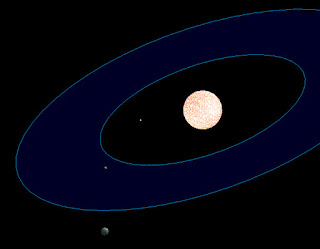 |
| Habitable Zone around a Red Dwarf star |
I've been fascinated by the idea of planets around other stars since I was young. In fact, I developed several fictional solar systems, one of which became the basis for an online gaming and science fiction club. That solar system is called Greeop System,[001] which inspired the development of many more solar systems and formed the basis of many gaming and fictional story plots.[002]
At some point, I stumbled across the book Rare Earth: Why Complex Life Is Uncommon In The Universe (2000), which is one of the earliest sources that discusses the idea of Habitable Zones around stars.
What's a Habitable Zone? If a terrestrial planet orbits its sun at just the right distance, that sun provides the right amount of light and other energy to make life more likely, given several other factors. If a planet is too close to its sun, it is likely too hot. If a planet is too far from its sun, it is likely too cold. This is why Habitable Zones are sometimes called Goldilocks Zones, in reference to the fairy tale Goldilocks and the Three Bears and finding options that are "just right" between two extremes.
In the past decade, the concept of Habitable Zone has been refined. From the study Habitable Zone Lifetimes of Exoplanets around Main Sequence Stars, it is now often defined similar to,
...the circumstellar distance at which surface temperatures allow liquid water to be present on the planet’s surface, assuming variable H2O/CO2/CH4 greenhouse forcings. The Habitable Zone has a minimum and maximum extent, forming inner (closer to the star) and outer boundaries that are set in part by biogeochemical climate feedback mechanisms and stellar luminosity.[003]
Yeah, Goldilocks metaphor seems to get the point across easier. The question is, what's "just right" for life? Star size and age appear to play the substantial roles in setting the limits of a Habitable Zone. Not only is the Habitable Zone different between large and small stars, it can move over the life-cycle of a star. For example, main sequence stars gradually output more energy over billions of years. A planet that initially forms within the Habitable Zone of a young star might not remain in the Habitable Zone later in the star's life-span. It is predicted that our Sun will be so hot in 1.75B years, surface water will no longer be possible on Earth, presumably making life on Earth no longer sustainable.[003]
If a planet has the right conditions and resides within the Habitable Zone, life still has to appear and evolve in some sort of sequence. Taking Earth as the only example we have,
Of course, a lot of this is based on assumptions that life on other planets will resemble life that formed on Earth. Maybe life of different kinds exist in the Universe.[004] The rules may be different for different kinds of life. Maybe Earth is extremely unusual. Worse, maybe we will not be able to immediately recognize other forms of life simply because it is so different from our experience. As more information is gathered, these issues will hopefully be addressed.
Pirmary reference:
Andrew J. Rushby, Mark W. Claire, Hugh Osborn, and Andrew J. Watson. Astrobiology. September 2013, 13(9): 833-849. doi:10.1089/ast.2012.0938, Habitable Zone Lifetimes of Exoplanets around Main Sequence Stars.
Response:
Voat.co
If a planet has the right conditions and resides within the Habitable Zone, life still has to appear and evolve in some sort of sequence. Taking Earth as the only example we have,
... this stepwise progression began with the origin of life, continued through the transition from replicating molecules to RNA and then DNA [1B years after Earth formation], from prokaryotes to eukaryotes [1.5 to 2.5B yrs after Earth formation] and cell differentiation [3.5 to 4B yrs after Earth formation], and concluded with the final step from primate to human societies [4.54B years after Earth formation].[003]However, if just one of these steps takes a lot longer, there is a drastically lessened chance of having enough time to develop intelligent life similar to humans; assuming the march toward more intelligent creatures is inherent to the process of evolution on different planets. Different stars may also extend or reduce the time-frame within which life may appear and develop. Larger stars will have short Habitable Zone lifespans. Smaller stars, such as Red Dwarfs may have very long and stable Habitable Zone lifespans.
Of course, a lot of this is based on assumptions that life on other planets will resemble life that formed on Earth. Maybe life of different kinds exist in the Universe.[004] The rules may be different for different kinds of life. Maybe Earth is extremely unusual. Worse, maybe we will not be able to immediately recognize other forms of life simply because it is so different from our experience. As more information is gathered, these issues will hopefully be addressed.
Pirmary reference:
Andrew J. Rushby, Mark W. Claire, Hugh Osborn, and Andrew J. Watson. Astrobiology. September 2013, 13(9): 833-849. doi:10.1089/ast.2012.0938, Habitable Zone Lifetimes of Exoplanets around Main Sequence Stars.
Response:
Voat.co
Article Series:
- Limited lifespan of Habitable Zones around other stars [and a loosely held secret finally revealed about me]
- Small stars may have stable Habitable Zones, but habitable planets might not be common there
- Habitable Planets around White Dwarfs
- Habitable Worlds Around Binary Star Systems might not match Sci-fi
- How many Earth-like planets are orbiting Sun-like stars?
- First round of life in the Universe might have been possible extremely early
- Factors a planet needs for suitability of life; perhaps
- "Goldilocks zone of metallicity" on a galactic scale
- Maybe we are the first
No comments:
Post a Comment